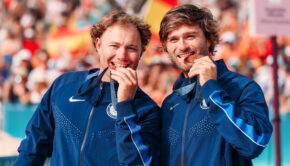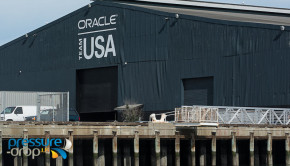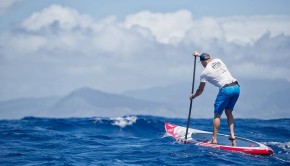Andrew Campbell: Newcomer of the Year
Published on January 25th, 2010
 (January 26, 2010) As the top North American at the 2010 Star Worlds last week in Brazil, American Andrew Campbell has quickly established himself as a leading contender for the 2012 Olympics… after only his first year in the class.
(January 26, 2010) As the top North American at the 2010 Star Worlds last week in Brazil, American Andrew Campbell has quickly established himself as a leading contender for the 2012 Olympics… after only his first year in the class.
Last week you were presented at the U.S. Sailing Team AlphaGraphics (USSTAG) Awards Banquet with the Best Performance by a Newcomer award. After completing your first season in the Star class in 2009, what has attributed to this quick climb in what is seen as perhaps the most competitive class?
At first I laughed and was actually a little surprised… I’ve been here the whole time, how could I have the best performance as a newcomer? Once I read the full description, I am flattered by the award. I’ve been working hard to make a fast transition into the new class. My expectations for myself are always high, and my emphasis is always on improvement through experience. This year has provided a ton of growth in my experience in the sport.
After representing the U.S. at the 2008 Olympics in the Laser, you have gone from the simplest class to one of the more complex. Describe the transition.
The beauty of the Star is how directly minor adjustments in the rig and sails changes the feel in the tiller. When you pull a little more backstay on, it makes a huge impact on making the boat feel better and faster; that is incredibly rewarding for any sailor. The Laser is as pure as it gets in the sport. The sailors make the difference in that class, and there is no excuse beyond your effort.
In the Star you have so many added dynamics – a crew, sail design, hull design, mast tune, etc. Sometimes the best juggler wins the event. Since my college sailing career where I learned how much I enjoy the team dynamic and juggling the additional variables, I’ve been seeking that in my sailing. The Melges 32 sailing and Star sailing have been very satisfying next steps. The to-do list is never-ending sometimes in the Star, but you just have to keep on top of it and it never gets too out of hand. Having a boat for the next event is always the biggest concern.
You have been the most consistent North American over the past two Star World Championships, yet these were your first two Star Worlds. What is it about the Worlds schedule that helped you adapt to this event?
I enjoy observing other sailors under stress at major events like the Worlds. Some change their approach completely; others are affected by stress in wild ways. Certainly I feel the heat like anybody else, I get tense at times, but in the end it’s just another boat race. I’m trying to improve my sailing every time I go out on the water, so the Worlds is just as big a learning experience as any other day of training. I stick to my routine and try and keep the pressure on the other sailors as best I can. Luckily, my style of conservative, consistent sailing, along with a sense of urgency allows for good scores and good comebacks in the Worlds format. Learning to be patient enough has been a lifetime in the works, but it pays off in the long event.
What were the primary differences between the Varberg, Sweden Worlds and the Rio de Janeiro, Brazil Worlds?

Varberg was all right side of the course, and Rio was all left. Varberg was cold, Rio was unbelievable hot. We had a team-oriented coach with Mark Ivey at Varberg and a technically-oriented coach with Ed Adams at Rio. I sailed with Magnus Liljedahl in Varberg and Brad Nichol at Rio. There were tons of differences, and the results were different (2009 – 5th; 2010 – 11th). I’m happy that we can be considered among the top players in the class. We will really have to work hard to make a push for the top in the next couple of years.
The Star class involves significant expenses. To what degree are you invested?
I’m very invested, but I don’t have a boat yet. I’ve taken some of the success I had in the Laser campaign and transferred that into the new boat, but the reality is that selling one Laser and all its equipment will effectively buy a set of sails for the Star boat. The sailors in the class are incredibly generous with their equipment and their experiences, so I’m already heavily indebted to a number of new friends in the class.
At the moment, I’ve been able to sail the entire year with chartered and borrowed boats. I’ve raced P Stars, Lillias, and Follis, and I’m learning the differences between the designs. In order to win the U.S. berth for the 2012 Olympics, I will need to have the right boat and the right sail development. I simply won’t be able to do that on my own, so I’m really at the mercy of the generosity of potential donors. Everything I have is invested in my sailing right now, and I’m having a great time working hard for good results. Sailing at this level without deep pockets can be ugly, but with the right support I have to believe I can do it.
If there was a Best Writing Performance, Scuttlebutt would select you and Anna Tunnicliffe. What motivates you to share your experiences (and how can we get the others to rise to your level)?
I’m flattered again to be considered with Anna for the writers vote! She’s got a great website, and I really enjoy keeping up to date with her campaign. When I first started writing on CampbellSailing.com, I wanted to find a way for my family and friends to see what I had been up to. It has evolved into a forum for me to show the guts and complexity of the sport, from the highs to the lows, from rules challenges to the daily grind. It provides a great outlet for me to dig deeper into my sailing, and I’m lucky that sometimes it can create some very valuable discussion for other sailors. I feel a responsibility to give back to the sport as much as I can, I’m extremely lucky to have had the support that I’ve had from so many sailors, it’s the least I can do.
Check out Andrew’s website at: www.campbellsailing.com









 We’ll keep your information safe.
We’ll keep your information safe.